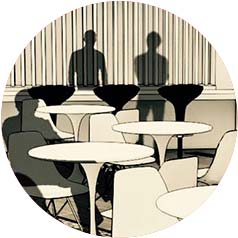Time traveller’s museum
The rain-swept waves lashed against the tripods at Marine Drive, Mumbai’s C-shaped boulevard. Parts of the drive appeared skewed, overwhelmed by the grey sea. How many dreams have lived and died on this edge? A new phone app called ‘The Time Machine’ promises to answer this question to a certain extent by allowing users to view the modern, techni-colour art deco buildings facing Marine Drive in their erstwhile sepia glory. The app combines GPS data, personal experiences and photographic uploads into chronological blogs that can be accessed by the mere touch of a button!
It is not the technology that amazes here. It’s the prospect of turning every urban place into a virtual museum, accessed from any palm or pad, and every urbanite into a curator that is fascinating. Unlike being just another museum in a burgeoning metropolis, the entire city could be a museum! Not one of fixed exhibits collecting dust under the apathetic hands of bored bureaucracy, but a dynamic retrospective reel of events and images built by the multiple vagaries of a participant public — a museum that is a repository not merely of the monumental but also of the mundane. Imagine transcending the Ramlila Maidan of the present through a past periscope that begins with a time before Shah Jahan to the unfurling of the national flag by Nehru to Anna Hazare’s fast. Or, revisiting your residence in the tightly-wound maze of old Delhi and witnessing its transitions, not merely through the stories of your grandmother, but through neighbours, shopkeepers and government records.
Historians could question how factually correct this app could be. Or perhaps this is a chance to experience history as a repartee of sorts, wherein the observer inquires and the city replies — not in numbed chronological facts or a disguised stiff upper lip but with varied views, wit, laced with humour, politically-correct and incorrect, or at times even with the angst and agony.
But can one take this beyond merely building the collective memory bank of a city and combine the two parallel obsessions of the Indian citizen — the past and the future. The former is often manipulated and the latter chased with faithful ferocity by swarms of card-picking parrots, flying on astrological charts. Based on land use master plans, national building codes, municipal bylaws and market norms, could this tool be used to model the abstract future of the Indian city?
While the possibilities are immense, can you imagine walking down crowded ‘old’ Ahmadabad, reeking with human sweat and enterprise, and scrolling it ahead by two decades only to see it as a flashy boutique district? Or pausing besides your favourite rocky outcrop, hidden from the pink bustle of Jaipur, to learn that it would be razed in the next few years to accommodate the new highway! And then take the recent car ad that propounds a petrol-efficient engine as it laments the loss of open roads in Mumbai to the cinematic tune of an old Shammi Kapoor song and cross-pollinate it, not with the present but with a virtual future, through time travel in which both the fossil fuel and the road are an endangered species! It may lead to a completely new way of designing the same stretch and not merely reconfiguring its use!
There is an opportunity here for city planner to not merely engage with democratic history but to arrive at the present via a hypothetical future. Rather than presume that the urban present is a linear derivative of the past, it should be a combination of its conjectural future too. Of course there will be loopholes in the future assumptions, and even errors. It could provoke protests and cause upheavals. Yet, right or wrong, abrasive or adhesive, it will every citizen taking responsibility of the present.
—
Suparna Bhalla
Published on September, 17th 2011




























